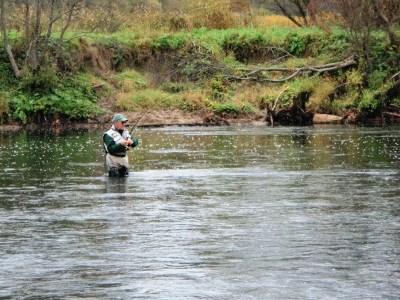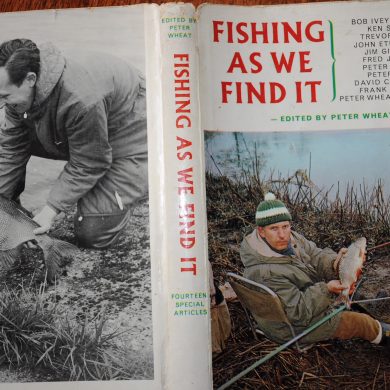Fly Fishing guide, instructor and author Jeremy Lucas notes the continued rise in interest in fishing for grayling this winter and adds his own distinct thoughts to the mix.
by Jeremy Lucas
I have noticed an increasing number of anglers turning their attention to the river, including during the harshest, cold weather in their search for that honourable fish, the grayling. This sport really has moved on considerably over the last 10 years or so, just as it did during those halcyon years of the 60s and 70s when the big reservoirs opened as stocked trout fisheries, followed by the proliferation of small still waters. There was a period of relative stasis, in my view, when although there was a hard-core of river fishermen in Britain (comparatively few in England), that was it and there was little real development. Even the still water sport seemed hardly to move on at all. Today, so many anglers are turning to the rivers. Perhaps it is the dynamism of flowing water, the ever changing nature of the fishing, and our need to hunt wild fish, both trout and grayling. As part of this renaissance, of course, is a wonderful level of expertise and sophistication.
Extraordinary to think that not so long ago we thought that 9′ five weights were de rigeur, with standard tapered leaders, along with traditional wet (including spiders and nymphs) and dry flies, with little regard to range and angle (because didn’t everyone just cast dry flies upstream and wet flies down, at whatever range was comfortable?), and still less for wading technique. Casting practice based on this old school has become so deeply entrenched in the collective psyche that it has been laid down in GAIA and AAPGAI instructor courses in a highly prescriptive way. And, of course, it is largely opposed to what we really need out there, because actual river fly fishing (with single-handed fly rod) just does not work like this. If I had my way I would teach instructors exactly as I demonstrate to my guests, precisely how to take on a trout and grayling river, which involves casting to a maximum range of 10 metres, usually less (almost all the instructor course content is based on a minimum casting range of 10 yards), and dealing with the far more important aspects of presentation (which also involves appropriate casting), such as angle of approach, tackle rig and, crucially, wading technique. After all, given adequate roll and overhead (or to and fro) casting at sub-10 metre range, all of my time with guests is spent considering the points of presentation that really matter. Most of the time, they can get by without knowing how to double Spey (though they quickly pick this up when actually in the correct position in the river) and such like, but they really cannot manage satisfactorily without all the other aspects of river technique.
Leaving all this to one side, I find myself constantly surprised at the numbers of anglers on the river today who have reached a very high standard indeed. In ten years we really have come a long way in this small area of the sport. I used to think that competitive fly fishing was the key component to development of the sport, but I think this is but one small aspect of it now. Much more important has been the wide ranging contemporary anglers, keen to learn how to maximise their time on the wild river. I can see, too, that the increase in popularity of destination fly fishing trips, particularly in Europe and Scandinavia (where there are grayling), has been instrumental to rapid progress. So the frontier, as I have known it, has shifted, and by quite a long way.
Today’s cutting edge tackle mirrors the needs of the presentation techniques explored by the vanguard of modern river fishers (though I wish that waders had reached the same standard). Four weights are the norm now, while many of the more adventurous use 10′ as a starting point and are seriously exploring with the contemporary range of 11′ (or in that region) rods in #3 and #2 specifications. At this length, and with the light, forgiving blanks that the top manufacturers are producing, hugely dexterous, ‘extreme’ nymph fishing technique can be explored, particularly the highly accurate and sensitive leader-to-hand technique or more generally just long leader (18′) nymphing. In this series I have written before about this technique, using rods up to 12′ in length, and incorporating indicator leaders – to hand or otherwise, but I suggested that I would write more and it strikes me that the time is now perfect for this, as I have had so many enquiries lately from anglers wanting to explore long rod, short-range river methods.
I think that many anglers compartmentalise fishing into nymph or dry, wet fly or spider, and perhaps streamer. Leaving out the latter, I feel that we can demonstrate that we are dealing rather with a continuum of presentation ranging from perhaps five feet depth (in winter) up to the surface, though in practice for much of the year that might be two and a half feet to the surface. The nymph under dry methods of duo and trio teach us a lot about this region of the river continuum, by making us think in terms of dry fly and nymph simultaneously. I think that the long rod and leader approach, combined with a short-range, stealth approach to the river takes us a step beyond this, out to the new frontier.
The key is to think three-dimensionally, about that continuum, or column of water where the fish are holding or feeding. If fish are rising then the solution is obvious, but it is when no or few fish are rising that we have to see, or imagine, below the surface, and then to be able to present a fly, be it nymph or spider, exactly where we need it to be. Think of it like this: unless trout or grayling are actively rising to flies on the surface, they tend to feed on nymphs at a constant depth, rising only to take nymphs that are in the final stage of ascendancy before ecdysis. It is, therefore, essential to get a fly to that depth, and this will change as you move through the river. This is where the long leader is so effective, particularly with a single or double nymph rig (and the dropper fly can often be an unweighted spider), because the stealthily wading angler can feed the flies into the 360 river surrounding him, always keeping the range sub-10 metres.
For me the ideal range for this approach has been just over six metres with a 10′ rod (Greys Streamflex #3 or #4), or eight to nine metres with an 11′ rod. Twice I have used a 12′ rod and been able to have good presentation and control just above 10 metres, but have felt a little uncomfortable, possibly because at this range I find myself relying more on touch than sight. As a bit of help, I suggest that absolutely the most important thing is to fish at appropriate range (and this is consistent for all methods). Do not try to cast too far. Always use your feet to close the range, not an over-range cast. Put your nymph(s) sufficiently upstream of your target area such that they will achieve the desired depth as they reach where you think the fish are holding. Thus ‘reading’ the water is another crucial skill of the successful river angler.
| Jeremy Lucas – Wilderness Fly Fishing |
| Jeremy Lucas is a member of the Hardy Greys Academy and former England all-round international. He is author of the book Tactical Fly Fishing. He guides mostly on the San River, Poland, and the Eden in Cumbria. These are the two top mixed trout and grayling rivers in Europe. He offers specialised, advanced fly fishing courses only on these rivers. These consist of week-long, small group visits to the San, and short courses on the Eden. Accommodation is arranged (always for the former, if required for the latter).See www.wilderness-flyfishing.co.uk for further information, or call on 07737 013604. |


